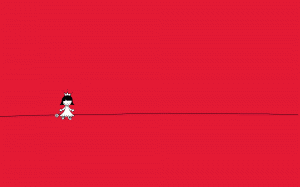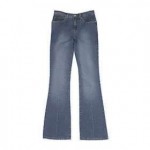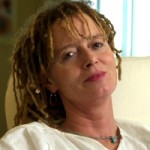Anyone remember that Muppet (Don Music, above) on Sesame Street who kept trying to play “Twinkle, Twinkle Little Star” on the piano? He would almost reach the end, then play the wrong note. Then he’d groan, “OH, I’LL NEVER GET IT! NEVERRRRR!” (and, sproing: the sound of his head hitting the piano keys.)
That’s how I felt about writing my artist statement for a grant application. Lately I’ve thought about that Muppet, a lot.
Writing the artist statement was one of the most productive writing assignments I’ve had on this blog. Translation: it KICKED my ASS over and over again. It was excruciating. I actually tried to write an artist statement back in November, for this same grant, and I actually missed the application deadline. Uncharacteristically, I gave up. Now, I usually let the pressure of the deadline work its magic, and Just Do It. But I didn’t, and I missed the deadline. I decided that I wouldn’t let the deadline pass me by again.
What paralyzed me for so long was, really, two things. The first thing was the perfectionist voice: it BETTER be good. I can understand how artist statements can be bad for those who have not been taught how to write. But, some voice sneered, a writer’s artist statement better be GOOD. Writers write, after all. We usually don’t paint or compose music or use other artistic forms to express ourselves. Words are what we have. I’ve read some terrible artist statements, ones which made the artist seem incredibly pretentious, or ones which made me respect the artist less. So my internal editor voice kept butting in: ’that’s SO cliche,” “that’s how EVERY artist statement starts,” and so on.
The second thing that paralyzed me was an issue of identity. Having been a professor and a scholar for so long, and having worked so hard to get there, it was hard for me to switch gears and claim myself as a writer. Writing the biography of myself as a writer, as an artist, then, was invaluable, and I had to write that before I got to the artist statement. I had to believe that I was—no, am—a writer.
Now in my teaching, I’ve asked my students to write artist statements. I’ve emphasized that artists need to be able to talk about their own work intelligently. Our culture demands (and gains) access to the artist and creative processes. Because of this demand, artists who can talk about their own work are often artists that I respect.
But in this case, ironically, I couldn’t let myself trust the writing process—the very process that I kept emphasizing as a writing teacher. As the editor Bill Germano says, “You don’t write to record; you write to discover.”
******
I wrote six drafts of my artist statement. Most of them felt miserable and inadequate. I complained most of the time. Which, come to think of it, is a pretty writerly process. I wanted to describe some of the drafts, so that if you are struggling with your artist statement, you could take some of the approaches below. Consider them writing prompts, or a mishmash of ways to brainstorm for the artist statement.
- In one draft, I wrote three anecdotes about the things that I write about frequently.
- Another draft made me erase the stories and anecdotes. I think I was trying to hide behind the stories, the equivalent of the artist’s plea, “Should my work speak for itself?” But on my way out the door for a run, some tough-love voice said to me: “No. You do know why you write what you write. To pretend otherwise is dishonest.” So I wrote for that voice for a little while. I did know why I write what I write; I just didn’t want to claim these things, and risk being vulnerable or wrong. I looked at the whys and the hearts of the anecdotes: what were the lessons or themes to take from the stories?
- In another draft, I wrote about the things I’d like to stand for, as an artist: education, literacy, compassion, questioning. (In Bird by Bird, Anne Lamott calls this your “moral point of view.”) They don’t describe what I do write about, all the time. And that gave me pause. I ended up putting these things into the statement anyway, because they do inform my work.
- The next draft brought me to a more honest place. I looked at a bunch of things I’d written, and tried to find common threads and themes. These themes didn’t match the lofty goals that emerged in the earlier draft. But they felt accurate, and they felt sincere. And they felt raw.
- Still another draft made me think about the emotional and psychological place that I inhabit when I write. The place where I’m writing freely and honestly, where I feel like I am doing good work. I thought about how I am scared by some of the things that I write, and I thought about Nikki Giovanni’s wonderful quotation, “If you’re not scared of your own work, it’s not doing anything.” And I’ve found that to be true: the writing that’s scared me the most is the writing that people respond to the most. That’s been my best writing. I thought about the strengths I try to access, the weaknesses I try to ignore, the wounds that I pretend don’t exist. I named those things, and I put them into the statement.
- I also thought about my goals as an artist, and thought about them as goals that I haven’t reached yet, rather than descriptions of what I actually do. To do this, I had to admit that my work does not always match my goals. There’s the artist I’d like to be, and there’s the artist that I am. I think there will always be a gap between the two, and I had to make peace with that. I know very few artists that are completely happy with what they’ve released in the world—there’s always something you can do, something you can fix. And I thought about the artistic struggle between what the artist wants the art to be (or their original vision of the art) and the art that emerges.
- I looked at the forms that I tend to use in my writing, in my blog posts and my creative nonfiction essays. I noticed that I like certain forms, such as the essay strung together with vignettes. I thought about the poetry classes I’ve taken, and how they’ve stayed with me because so much of my work is image-driven.
- I thought about how I wanted to challenge myself as an artist, and how challenge is a goal for my writing. I do want to challenge myself, and I want to keep learning. I added something in the statement about how I value the work that is making art.
I sent the draft, a sad little cluster of sentences, to a writer friend from Twitter who generously offered to read it. She gave me wonderful and thorough comments on the rest of the application, including a biographical statement. But she liked that little cluster of sentences. I knew I had to write more. And that was enough to get me through the rest.
Most of all, I wanted the statement to clarify my writing. I wanted it to illuminate my writing, the way that sunlight illuminates the colors of stained glass. What emerged is not a great artist statement, but I think it describes what I do, and clearly. It’s a good beginning. I know I’ll revise it again. I’ll revise it one more time, and put it up here in the next post. I’ll try to add more about what I learned about artist statements, too.
I’m just glad I made it this far. For now, I want to remember how it felt when I finished that last draft. How I closed my eyes and took a deep breath before I hit “send” on the grant application. “It’s taken me twelve years to return,” I wrote in my biographical statement. “But I’m a writer again.”





